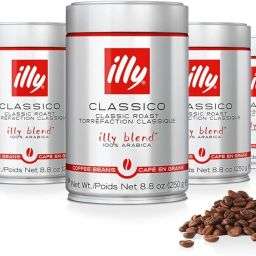
The essence of a great cup of coffee lies not just in the brewing technique but equally in how the coffee beans are stored prior to brewing. Freshness and flavor are paramount; hence, proper storage becomes a critical aspect of coffee preparation.
Coffee beans are sensitive to environmental conditions; their exposure to air, moisture, heat, and light can rapidly degrade their quality. This degradation not only affects the aroma but also the subtle flavors that make each brew unique.
Therefore, understanding and implementing effective coffee storage solutions is essential for any coffee aficionado aiming to preserve the integrity of their beans.
Why Airtight Containers?
Impact of Environmental Factors
The four main adversaries of coffee bean freshness are air, moisture, heat, and light. Each of these elements plays a role in the deterioration of coffee beans:
- Air: Oxygen in the air starts a process of oxidation with coffee beans, leading to stale and flat flavors.
- Moisture: Humidity or moisture can cause coffee beans to become damp, leading to mold growth or further oxidation.
- Heat: Elevated temperatures accelerate the chemical reactions that degrade coffee beans, hastening loss of flavor.
- Light: Exposure to light, especially UV rays, can alter the molecular structure of coffee beans, diminishing their quality.
Airtight Containers as a Solution
Airtight containers offer an effective solution to these challenges. By creating a seal that prevents air from entering and interacting with the beans, these containers significantly slow down the oxidation process. Furthermore, airtight containers protect the beans from moisture and light, especially if the containers are opaque or stored in a dark location.
The insulation properties of these containers can also shield the beans from heat fluctuations, providing a stable environment that preserves the beans’ freshness and flavor for a longer period.
Airtight storage options come in various materials, including glass, ceramic, and stainless steel, each offering its advantages in preserving coffee bean quality. The key is to choose a container that not only seals tightly but also fits the specific needs of your storage space and coffee consumption habits.
Understanding Airtight Containers
Types of Airtight Coffee Containers
When selecting an airtight container for coffee storage, the material of the container plays a pivotal role in preserving the quality and freshness of the coffee beans.
Three primary materials are commonly used: glass, stainless steel, and ceramic. Each material offers distinct benefits and potential drawbacks that coffee enthusiasts should consider.
- Glass: Glass containers are inert, meaning they do not interact chemically with the coffee beans, preserving the beans’ natural flavors. They often come with airtight seals and are easy to clean. However, glass is transparent, allowing light to penetrate and potentially degrade the coffee quality unless stored in a dark place.
- Stainless Steel: Known for its durability and light-blocking capabilities, stainless steel containers offer excellent protection against light and air. Many high-quality models come with additional features like vacuum seals and CO2 release valves. The main drawback is that they can be more expensive than other materials.
- Ceramic: Ceramic containers offer a balance between aesthetics and functionality. Like glass, ceramic is non-reactive, and if the container has a tight-fitting lid, it can be effective at keeping air out. Ceramic containers often come in various designs, adding a decorative touch to kitchen counters. They block light effectively but can be fragile.
Several brands and models stand out in the market for their quality and specific features designed to enhance coffee storage:
- Lovffee Coffee Storage Canister: This container is noted for its airtight seal and patented venting system, which allows CO2 to escape while preventing air from entering.
- Coffeevac: A straightforward, functional design characterizes this container, with a unique valve system for releasing pressure without letting air in.
- Friis Coffee Vault: Offers a combination of airtight sealing and a CO2 release valve to keep coffee fresh.
- Coffee Gator Canister: Distinguished by its stainless steel construction, CO2 release valve, and a date tracker to monitor freshness.
- Fellow Canister Storage: A premium option with a vacuum pump feature integrated into the lid for removing air, available in clear glass or stainless steel to block light.
Key Features to Look For
When choosing an airtight container for coffee storage, several key features are essential for maintaining the beans’ freshness:
- Vacuum Seal Capabilities: A vacuum seal removes air from the container, slowing down the oxidation process that degrades coffee quality. Containers with a vacuum seal, such as the Fellow Canister Storage, offer superior freshness preservation.
- CO2 Release Valves: Freshly roasted coffee beans release CO2, which can build up inside a sealed container and affect the beans’ flavor. Containers equipped with a CO2 release valve, like the Friis Coffee Vault and Coffee Gator Canister, allow gases to escape without letting air in.
- Size and Capacity Considerations: The size of the container should match your coffee consumption habits. A container that’s too large for the amount of coffee stored can lead to excess air being trapped inside, speeding up degradation.
- Opacity to Block Light: Light, especially UV light, can adversely affect the quality of coffee beans. Opaque containers made of stainless steel or ceramic, or glass containers stored in dark places, are preferred to prevent light exposure.
Selecting the right airtight container involves balancing these features with personal needs and preferences, ensuring coffee beans remain as fresh and flavorful as possible.
Budget-Friendly vs. Premium Options
In the realm of airtight containers for coffee storage, options range from budget-friendly to premium, each catering to different needs and preferences.
For those conscious of their spending, the Oggi 4-Piece Acrylic Canister Set presents a cost-effective solution. While offering the convenience of multiple containers for various storage needs, this set compromises on specific features like UV protection and a robust airtight seal, making it less ideal for long-term coffee preservation but suitable for short-term storage and general kitchen use.
Conversely, the Fellow Atmos Vacuum Canister represents the premium end of the spectrum. Engineered with a vacuum seal technology that actively removes air from the container, it provides an unparalleled level of protection against the factors that degrade coffee.
Along with its sleek design, this canister includes features such as a vacuum lock indicator and the ability to store coffee at a fraction of atmospheric pressure, significantly extending the freshness of coffee beans. While its higher price point reflects its advanced features and design, the investment is justified for those seeking to maintain optimal coffee quality.
Storing Coffee Long-Term
For long-term storage of coffee, maintaining freshness is key. A common debate centers around refrigeration and vacuum sealing. While refrigeration can protect coffee from heat and light, it can also introduce moisture and cause condensation, potentially harming the beans.
Vacuum sealing, on the other hand, removes air from the storage container, slowing the oxidation process and preserving the coffee’s flavor and aroma for extended periods. The optimal strategy involves using a vacuum-sealed, opaque, and airtight container stored in a cool, dark place to protect against the detrimental effects of air, moisture, heat, and light.
FAQs
- Does coffee expire? While coffee doesn’t “go bad” in the traditional sense, its quality and flavor degrade over time due to exposure to air, light, and moisture.
- Is an airtight container necessary for coffee storage? Yes, to prevent oxidation and moisture absorption, which can significantly impact the coffee’s flavor profile.
- Should you refrigerate your coffee? It’s generally advised against refrigerating coffee because temperature fluctuations can affect its taste. Instead, store it in a cool, dark place.
- Can old coffee make you sick? Drinking coffee made from old beans won’t make you sick, but the flavor and aroma may not be as pleasant.
- Are coffee jars airtight? While many jars claim to be airtight, true airtightness varies. Look for containers specifically designed for coffee storage with features that prevent air ingress.
These insights and FAQs address common concerns and best practices for storing coffee, ensuring enthusiasts can enjoy the best possible cup from their beans.
Final Thoughts
Selecting the right airtight container and adhering to proper storage practices are critical for preserving the freshness and flavor of coffee beans.
The material of the container, whether glass, stainless steel, or ceramic, plays a significant role in protecting coffee from air, moisture, heat, and light.
Premium options like the Fellow Atmos Vacuum Canister offer advanced features such as vacuum sealing and CO2 release valves, which further extend the freshness of coffee beans.
However, budget-friendly choices can still provide adequate protection for short-term storage needs. Ultimately, investing in a quality airtight container and following best storage practices ensures that coffee enthusiasts can enjoy a superior cup of coffee every time.









